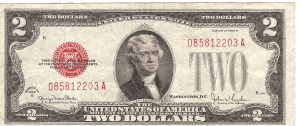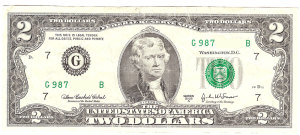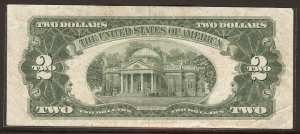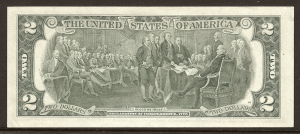I recently came across an article entitled “The Curious Case of the $2 Bill” which was written by a student of Ancient History. I’ve long been a fan of “Toms” (as they are often called, since a portrait of Thomas Jefferson appears on the face of the bills), and judging from my experience a lot of people think they are ancient history.
I enjoy spending them, and when I do, a common reaction is, “Oh, are they still making those?” or “I haven’t seen a two-dollar bill in years!” Clearly, they are not widely circulated.
In some years, however, the Bureau of Engraving and Printing issues several million of these quaint pieces of legal tender. [The web page just linked, btw, is a bit out of date. It says (as of this writing) that “The most recent printing of the $2 note has the Series 2003 date” when in fact the latest series is 2013, and there have also been notes printed in the 2003A and 2009 series.]
The last major redesign of the $2 bill was for the 1976 series, as part of the celebration of the 200th anniversary of the Declaration of Independence. For that series, the reverse of the bill, which previously had carried a picture of Jefferson’s Monticello, was replaced with a picture of the signing of the Declaration. Beginning with that series, here are the statistics of how many have been printed.
- The 1976 series was printed from 1976 through 1979. About 592 million bills were created. It’s not uncommon to find examples of this series in excellent condition. In contrast, one-dollar bills of that era are quite scarce in circulation.
- The 1995 series were all printed in 1996 (go figure!) and totaled about 155 million bills.
- The 2003 series were all printed in 2003, and about 125 million of those were issued.
- The 2003A series were printed in 2006, and nearly 231 million of those were printed.
- The 2009 series were all printed in 2012. About 125 million of those were put out there.
- So far, only about 32 million of the 2013 series have been printed.
If you add all of this up (and I did), it seems that nearly 1.3 billion $2 bills have been printed and issued to the public in the past 37 years. That’s an average of about 34 million a year. Assuming that most of these have survived (granted that many of them will have been lost, destroyed, shredded by the Fed, or placed in collections), that would be a handful per capita. Clearly, the production of these bills has been dwarfed by the more common denominations, but $2 bills are hardly rare, or even scarce. Yet that myth persists, because most people rarely see them.
Here’s a picture of the face of the bills before and after the redesign of 1976. It no longer says “will pay to the bearer on demand”…
All of the pictures of bills here, btw, are notes that are, or have been, in my possession. You can click the images to see larger images of my scans.
In that “Curious” article, they talked about the lack of a slot in cash registers for $2 bills, but I don’t think it was always that way. Or, maybe they had the same number of slots but have been repurposed. I guess one could find out with a bit of internet research, but I’m not so inclined.
I grew up in a small New England town in the 1950s, and cash was King. There were no credit/debit cards in those days (if you wanted to run up a bill at a local merchant — and they permitted that — you just said “put it on my account” and that was it).
Cash registers were not adding machines. When I went in to the local IGA with my father (he brought me along because he wanted to use my little red wagon to wheel the groceries home), there was no self-service. He consulted the list given him by my mother, and pointed to cereal boxes or whatever, and Joe Galeisha would get them off the shelf. If they were high up, he would use one of those grabbers. He brought them back to the counter and with a large pencil he wrote down the price on a paper bag. When all was done, he added it up and told my father the total, which was given in cash. Joe rang it into the cash register. There was (in my memory) a slot for $2 bills, which were commonly used. There were also places for half dollars and silver dollars, also commonly used. Indian Head pennies were not common, but were not all that unusual. My favorites were the zinc cents of 1943.
If we ran out of something, my mother would send me to the store to get a quart of milk and loaf of bread, and told me I could spend the change on candy. She gave me a quarter. Cokes were a nickel. So were phone calls and cups of coffee. Nostalgia!
Another curious thing in the “Curious” article is a statement about the first of two New York Times articles that are linked (the first one is behind a paywall).
The article reported government trepidation that a bicentennial bill would also be held out of circulation as a souvenir.
That’s a bit silly. The government would love to have people stick the bills in their sock drawer and never use them. The loss of currency in circulation to any cause is called seigniorage, although that word has other meanings, too. It is basically the profit made when the public pays more for a coin or bill than its cost, and does not redeem it. So, “trepidation” that the Treasury would make a profit? Hardly!
I have many stories about spending Toms, and I share those and read others in an online forum I visit fairly regularly. I guess my favorite one was from two or three years ago when I stopped for gas, and a cup of coffee, on the Mass Pike, headed to Boston. I took my coffee to the counter and handed the young clerk a $2 bill. She smiled and handed it back to me. “I can’t take that!” she said. “Why not?” I asked. “It’s not real!” she insisted.
So watch this space for more developments. A new documentary movie is now in the final stages of production.
A fitting way to end this post, I suppose, is to show the back side of the two-dollar bill before and after the 1976 revision.





3 pings